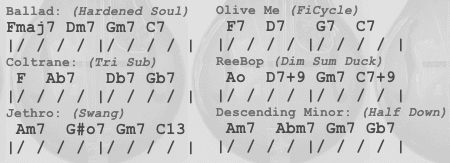« 4 and 7. The Committal Notes. |
Main
| Sitting on the edge of their seats »
 September 17, 2009 | Applying Turnarounds September 17, 2009 | Applying Turnarounds
If you were about to sit down for an extended break to read a book or the newspaper, you might do a few things in preparation. You might refill your coffee mug, take a look out the window to check the weather, make sure you don't have any phone messages, clear clutter off the couch where you are about to sit, or turn the background music softer so you can concentrate. These are any number of actions that aren't actually the act of sitting down or reading, but one of preparing for a long period of "stability."
Bluegrass and jazz musicians have something in common in that they take a song or chorus, and improvise over the same set of changes, sometimes ad nauseum. You start off in a key, you end in that same key. In order to make each return to the beginning sound "fresh," a good understanding of the implementation of Turnarounds can give your improvisation (and comping) new life. It can be a simple as hitting the V7 or Dominant chord of the key, or as complex as a set of tritone subs inserted in a string of secondary dominants. (Huh?)
We touch in our Blues 501 page the notion of Turnarounds, but very briefly. If you blinked, you might have missed it. There's a little more depth in the "Getting Into Jazz Mandolin" book (not-so shameless plug...), and we won't rehash it here. It's worth a visit to this ancient archive:
Blues 501

A word of caution here--you can get intimidated by a rash of deep music theory terms, or you can simply get out your mandolin and just play through the chords, enjoy them for their sound, never minding the labels or terminology. It all comes back to the ear anyway, but once you do get the sound, it is nice to eventually get a grip on how to duplicate this in multiple keys.
Okay, "Ask me the time, and I'll tell you how to build a watch." That's not what we want to accomplish here; we just want to get you some new, repeatable concepts that might take months or years to completely digest in full depth.
Our friend and jazz mandolin mentor, Paul Glasse brought to our attention a terrific online article by Dr. Matthew Warnick, "Turnarounds: How to Turn One Chord into Four" at goes into much more detail, explaining heavier concepts like secondary dominants and tritone subs. Again, you might not be ready for the deeper theory, but don't let this scare you. If you just play through the chords in the one key it's presented in (key of C), you can transpose this into others, and apply to songs you already know.
Read Jazz Guitar Online article: Turnarounds: How to Turn One Chord into Four
Another thing about Turnarounds is they aren't just for the end of the song. You can also use them at the ends of phrases, and even take the concept deeper into the song itself and start applying chord substitutions in more harmonically stagnant parts of the music. See what we did with a traditional fiddle tune, Red Lion Hornpipe , AKA "Carpal Tunnel Hornpipe." This is all about the Turnaround.
Further:
Circle of Fifths
Secondary Dominants
Jazzed Pentatonics
FFcP Testimony
Posted by Ted at September 17, 2009 9:12 AM

Disclaimer: In the 'Information Age' of the 21st Century,
any fool with a computer, a modem, and an idea can
become a self-professed 'expert." This site does not
come equipped with 'discernment.'
|



